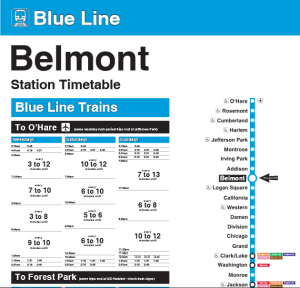What do bus schedules have to do with a lean management system? Quite a bit…even though, obviously, the notion of a bus schedule is more metaphor (or is that analogy?) than reality. Effective lean management systems are largely constituted by “mechanics” and lean leadership behaviors. The mechanics include, among other things:
Quite a bit…even though, obviously, the notion of a bus schedule is more metaphor (or is that analogy?) than reality. Effective lean management systems are largely constituted by “mechanics” and lean leadership behaviors. The mechanics include, among other things:
- tiered meetings (a.k.a. huddles or reflection meetings) to drive alignment and problem solving,
- gemba walks during which leaders check the adherence to/sufficiency of standardized work
- andons to flag and quickly respond to abnormalities and drive timely containment and problem solving at the lowest/most appropriate level in the organization
- one-on-one coaching to facilitate problem solving and personal development of the coachee
These are critical elements that must “cascade” through multiple levels in the organization. Tiered meetings, by their very nature roll bottom-to-top, for example the natural work team meeting(s) occur first, followed by the value stream tiered meeting, etc. Similarly, there is built-in redundancy in gemba walk based standardized work. For example, the team leader, group leader, and value stream manager may “check” the same stuff, but will do so with differing frequency. The basic underpinnings of all standardized work are sequence, standard WIP (SWIP), and takt time. To that we can easily extrapolate to steps, sequence, timing, cycle time, SWIP, and takt time. …Which gets us to the bus schedule. All of the lean management system elements must follow a cadence and with that, an explicit and synchronized schedule. Without that, there is chaos and a system that is not very systematic, and thus not effective. Ultimately, these notions get us to lean leadership behaviors which include respect for the individual and consistency. Respect for the schedule is respect for people. The mature lean organization maintains a profound and pervasive respect for the schedule and thus the scheduled times to conduct tier meetings, gemba walks, and one-on-one coaching meetings. Not only do we want to ensure the right stuff gets done at the right time, we want to instill a rhythm of expectation and execution within the organization. I'm probably stating the obvious, but it is nearly impossible for lean leaders to:
- check the adherence to/sufficiency of the leader standard work and the application of lean leadership behaviors of their subordinates if they don't know when the observable events (huddles, gemba walks, one-on-ones) are going to occur. And, if the leaders can't directly observe, their coaching will be less than effective.
- Avoid setting meetings and other commitments for folks that will compete with the lean management system activities.
Therefore, the schedule must be pervasively known and understood throughout the organization. It should only be violated in very, very extreme situations. (Of course, we know that leaders will occasionally have someone else cover for them, but the "show must go on.") And, the standardized schedule should be adjusted only when the lean management system is adjusted for improvement’s sake. So, how’s your bus schedule? And, are your buses running on time? Related posts: How to Audit a Lean Management System, Build the Lean Management System and the Behaviors Will Come. Not Exactly.
